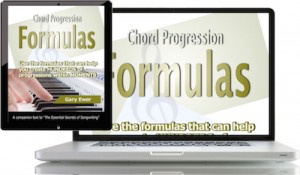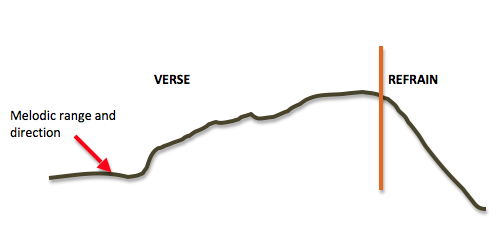In common usage within the pop genres, a refrain is a closing line at the end of a verse, usually used in place of a chorus. A classic example is Bob Dylan’s “The Times They Are a-Changin'”.
 “Chord Progression Formulas” shows you how to create dozens of great progressions practically instantly by using some powerful formulas. Get it separately, or as part of “The Essential Secrets of Songwriting 10-eBook Bundle”
“Chord Progression Formulas” shows you how to create dozens of great progressions practically instantly by using some powerful formulas. Get it separately, or as part of “The Essential Secrets of Songwriting 10-eBook Bundle”
That song’s a good example because it demonstrates some of the important characteristics and qualities of typical refrains:
- The melody, chords and lyrics are the same for each refrain. The verses that are attached to the front end, of course, will usually be different, but the refrain is normally the same.
- A refrain usually means that the song won’t use a chorus.
- A refrain’s melody often starts higher and moves lower, which means that the song’s high point is near the end of the verse. (Sometimes the high point might happen at the start of the refrain, like you hear in “Bridge Over Troubled Water.”
- A song with a refrain will often use a bridge to offer something to contrast with a constantly repeating verse melody and chords.
A song’s verse needs to lead smoothly into the refrain, so that means that the chords that happen at the end of the verse need to sound incomplete, as if it needs to refrain to make the verse-refrain unit sound complete.
And that’s actually an important point to consider — the fact that a verse and refrain is a unit. You might be able to play a refrain on its own, but it will sound very short. Moreover, the lyric of a refrain usually needs the verse to help it make sense. Simply singing, “Oh, the times, they are a-changin'” may not offer much that an audience can fully appreciate. But put it at the end of a verse of other thoughts and observations, and suddenly that line makes a lot more sense.
The High Point
One of the more important qualities of a refrain is that it allows the energy that comes along with a verse’s high point to release itself and die away. The melodic range of “The Times They Are a-Changin'” is relatively restricted: mainly a perfect fifth.
Toward the end of that verse, on the words “Then you better start swimmin’ or you’ll sink like a stone“, we hear the verse’s highest note repeat over and over, building energy and excitement. The refrain then moves the melody downward, and that offers the release of energy that most refrains create.
That probably winds up being the most important feature of a refrain — not the fact that it’s short, or usually contains the song’s title (though those points are true). It’s more that a verse-refrain structure typically has the verse ending high, with the refrain bringing everything lower:

There is a danger in opting for the verse-refrain design for a song, which is that as listeners we pick up a very noticeable sameness, one song to the next. You can do ten songs in verse-chorus format, but two or three verse-refrain songs start to sound overly similar, as if you’re copying your own work.
But any good songwriter should already be thinking carefully about changing key, tempo, feel, instrumentation, lyrical content, etc from one song to the next one. Formal design is simply one more aspect of writing you should be cautious about. A good verse-refrain song means: it’s time to move on to another design.
 Written by Gary Ewer. Follow Gary on Twitter.
Written by Gary Ewer. Follow Gary on Twitter.
 “The Essential Secrets of Songwriting” 10-eBook bundle is being used by thousands of songwriters to polish their technique and develop their songwriting process. Don’t miss today’s FREE deal: a copy of “Use Your Words!”
“The Essential Secrets of Songwriting” 10-eBook bundle is being used by thousands of songwriters to polish their technique and develop their songwriting process. Don’t miss today’s FREE deal: a copy of “Use Your Words!”










